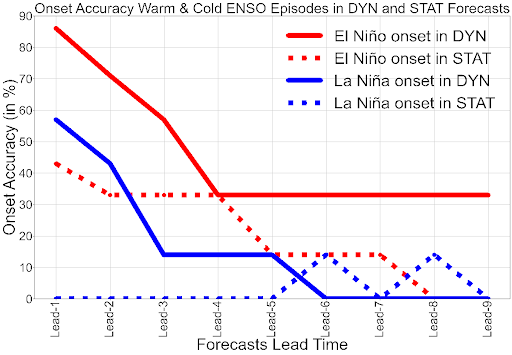When models miss the mark: Two decades of low-skill predictions in ENSO phase transitions
El Niño-Southern Oscillation (ENSO) phase transitions—shifts between neutral, La Niña, and El Niño states—reshape global climate patterns and are crucial for agriculture, water management, and disaster preparedness planning. Despite significant advancements in ENSO forecasting, predicting the precise timing of phase transitions remains a major challenge (Fig. 1). For over two decades, the International Research Institute for Climate and Society (IRI) has been collecting real-time ENSO forecasts from institutions worldwide, using both dynamical models (which simulate ocean-atmosphere interactions through physics-based equations) and statistical models (which rely on historical relationships between climate variables). In a study published in npj Climate and Atmospheric Science, Ehsan et al. analyzed 253 real-time Niño3.4 index forecasts—a key ENSO indicator measuring sea surface temperature anomalies in the central-eastern Pacific (5°S–5°N, 120°–170°W). The study found that DYN models (multimodal means of dynamical models) outperformed STAT models (multimodal means of statistical models), particularly for forecasts initiated between late boreal winter and spring months—known as the “spring predictability barrier,” a notoriously difficult period for ENSO forecasting. DYN models achieved 60% accuracy in predicting El Niño onsets up to three months in advance, whereas STAT models performed significantly worse. A key finding of the study, illustrated in Figure 1, is the marked difference in the predictability of warm (El Niño) and cold (La Niña) ENSO events. While DYN models demonstrated strong skill in forecasting El Niño onsets months ahead, their accuracy for La Niña predictions was much lower—ranging from 40–60% at two-season lead times and dropping to near-zero for longer leads. In contrast, STAT models showed little to no skill in predicting La Niña events, even at the shortest lead times.
The study highlights that ENSO phase transitions are inherently challenging to predict, with their success depending on both the model used and the specific event. ENSO phase transitions, such as the 2017 La Niña, continue to defy even the most advanced forecasts, underscoring the inherent difficulty in predicting these complex shifts. Therefore, even though models excel at predicting mature ENSO phases, accurately identifying ENSO phase transitions remains a critical hurdle. Given the societal importance of reliable ENSO predictions for improving forward planning, reducing economic losses, and enhancing resilience in climate-sensitive regions, these findings underscore the urgent need for further research into this complex yet impactful topic of ENSO forecasting.
Real-time ENSO forecast skill evaluated over the last two decades, with focus on the onset of ENSO events (npj Climate and Atmospheric Science)
Topics
- ENSO
- Modeling

